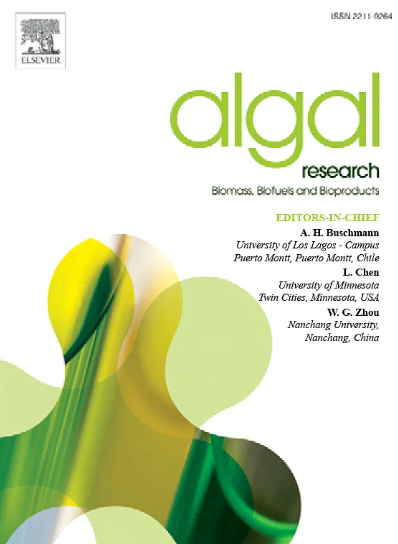Scale-up study of enhancing algal growth through bioaugmentation with the indole-3-acetic acid producing bacteria Azospirillum brasilense
IF 4.6
2区 生物学
Q1 BIOTECHNOLOGY & APPLIED MICROBIOLOGY
Algal Research-Biomass Biofuels and Bioproducts
Pub Date : 2025-06-21
DOI:10.1016/j.algal.2025.104163
引用次数: 0
Abstract
Algae-based wastewater treatment technologies can recover nutrients while generating algal biomass with diverse application potentials. While numerous bacteria have demonstrated the ability to enhance algal growth through symbiotic relationships in laboratory settings, scaling this benefit to larger applications remains challenging due to complex wastewater conditions and microbe-algae dynamics. This study explores the effectiveness of bioaugmentation with Azospirillum brasilense, a plant growth-promoting bacterium known for producing the phytohormone indole-3-acetic acid (IAA), in boosting algal productivity within an Algaewheel wastewater treatment system. Through a series of experiments conducted at lab-, pilot-, and full-scale levels, we evaluated the impact of bioaugmentation on algal growth and developed a bioaugmentation strategy for an Algaewheel system. The results indicate that a biweekly dosing, achieving a final bioaugmenting cell density of 0.2–4 × 109 cells/L, effectively doubles the biomass productivity in a residential subdivision wastewater treatment plant in Northern Illinois. The bacterial production of IAA was the primary mechanism driving this enhancement, as demonstrated by the similar growth and yield improvements observed with chemically supplemented IAA and bioaugmentation across all experimental scales. High-throughput sequencing of 18S rRNA genes revealed that the algal community in the bioaugmented tank exhibited more stable biodiversity than the control. Additionally, bioaugmentation improved nutrient removal efficiency during winter, highlighting its potential to enhance the overall performance and sustainability of algae-based wastewater systems. The developed bioaugmentation and chemical treatment methods offer further operational solutions for managing yield, optimizing biochemical profiles, and enhancing biofuel production potential.

吲哚-3-乙酸产菌巴西氮螺旋菌生物强化促进藻类生长的规模化研究
藻类废水处理技术可以在回收营养物质的同时产生具有多种应用潜力的藻类生物量。虽然许多细菌已经在实验室环境中证明了通过共生关系促进藻类生长的能力,但由于复杂的废水条件和微生物-藻类动力学,将这种优势扩展到更大的应用仍然具有挑战性。本研究探讨了Azospirillum brasilense(一种促进植物生长的细菌,以产生植物激素吲哚-3-乙酸(IAA)而闻名)生物增强在Algaewheel废水处理系统中提高藻类生产力的有效性。通过在实验室、中试和全尺寸水平上进行的一系列实验,我们评估了生物增强对藻类生长的影响,并为Algaewheel系统制定了生物增强策略。结果表明,在伊利诺斯州北部的一个住宅小区污水处理厂,每两周添加一次,最终生物增强细胞密度达到0.2-4 × 109个细胞/L,有效地使生物质生产力翻了一番。细菌生产IAA是推动这种增强的主要机制,正如在所有实验规模上化学补充IAA和生物增强观察到的相似的生长和产量提高所证明的那样。18S rRNA基因高通量测序结果显示,生物增强池中藻类群落的生物多样性比对照池更稳定。此外,生物强化提高了冬季营养物去除效率,突出了其提高藻类废水系统整体性能和可持续性的潜力。开发的生物强化和化学处理方法为管理产量、优化生化特征和提高生物燃料生产潜力提供了进一步的操作解决方案。
本文章由计算机程序翻译,如有差异,请以英文原文为准。
求助全文
约1分钟内获得全文
求助全文
来源期刊

Algal Research-Biomass Biofuels and Bioproducts
BIOTECHNOLOGY & APPLIED MICROBIOLOGY-
CiteScore
9.40
自引率
7.80%
发文量
332
期刊介绍:
Algal Research is an international phycology journal covering all areas of emerging technologies in algae biology, biomass production, cultivation, harvesting, extraction, bioproducts, biorefinery, engineering, and econometrics. Algae is defined to include cyanobacteria, microalgae, and protists and symbionts of interest in biotechnology. The journal publishes original research and reviews for the following scope: algal biology, including but not exclusive to: phylogeny, biodiversity, molecular traits, metabolic regulation, and genetic engineering, algal cultivation, e.g. phototrophic systems, heterotrophic systems, and mixotrophic systems, algal harvesting and extraction systems, biotechnology to convert algal biomass and components into biofuels and bioproducts, e.g., nutraceuticals, pharmaceuticals, animal feed, plastics, etc. algal products and their economic assessment
 求助内容:
求助内容: 应助结果提醒方式:
应助结果提醒方式:


